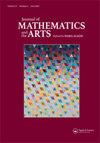Illustrating Euclid inspired by the Axioms of Kandinsky
IF 0.2
Q4 MATHEMATICS, INTERDISCIPLINARY APPLICATIONS
引用次数: 0
Abstract
Before I studied mathematics, I had already finished my studies in design with a focus on Illustration and 3D-Animation. My teacher in art philosophy used to say ‘Art is always contradictory, if you are confronted with a piece of art and you can decipher it completely, you can be pretty sure that you are looking at kitsch’ (Engelmann, 2003). One should not take this statement as a general rating, since it does not distinguish between good and bad art. It also includes that kitsch could be work of high artistic quality (although one should pause for a moment to think about what this implies for math-art in general, since mathematics is not very suitable to capture contradictions). But it shows a huge difference between art and illustration: while art is about asking questions, illustration is about giving answers. When you are looking at assembly instructions for an IKEA shelf or a mathematical proof, you want the illustrations to be as clear as possible. Children’s book illustrations normally give us answers about the characters and the surrounding world while an illustration of a poem is supposed to capture the mood and rhythm of the poem. Of course these boundaries are very blurry, so in the following I want to present some illustrations that concentrate on the ‘poetic’ side of mathematical proofs. Inspired by musical compositions, Wassily Kandinsky developed a (very flexible) axiomatic system that enabled him to construct his abstract paintings. In his bookPoint and Line to Plane (Kandinsky, 1926/1955) from 1926 Kandinsky claims that points are the primal element of every painting. A line is the trace of a moving point, and the characteristics of a line or the resulting shapes are defined by the movement of the points. The combination of points, lines, and shapes on the canvas creates tension that we perceive intuitively when we study an artwork, but which in principle could be measured mathematically, if one understands the underlying grammar of the art-language. His approach to not take nature as a model for his paintings, but to instead construct his compositions out of simple geometrical forms was a radical break with the predominant traditions. He claimed to be the first, whoever painted an abstract painting. But there are other contenders who created abstract paintings around the same time, like Robert Delaunay, Piet Mondrian and Hilma af Klint, who could also be regarded as the first abstract painter, depending on your definition of abstract art. To some degree his approach resembles the work of Euclid, who a few thousand years before also developed a (very rigid) axiomatic system based on simple geometrical forms.受康定斯基公理启发,阐释欧几里得
在学习数学之前,我已经完成了设计的学习,主要是插画和3d动画。我的艺术哲学老师曾经说过“艺术总是矛盾的,如果你面对一件艺术作品,你可以完全解读它,你可以很确定你在看媚俗”(Engelmann, 2003)。人们不应该把这句话当作一般的评价,因为它没有区分好与坏的艺术。它还包括媚俗化可以是高艺术质量的作品(尽管人们应该停下来思考一下这对一般的数学艺术意味着什么,因为数学不太适合捕捉矛盾)。但它显示了艺术和插图之间的巨大差异:艺术是关于提出问题,而插图是关于给出答案。当你在看宜家货架的组装说明或数学证明时,你会希望插图尽可能清晰。儿童读物插图通常给我们关于人物和周围世界的答案,而诗歌插图应该捕捉诗歌的情绪和节奏。当然,这些界限是非常模糊的,所以在下面我想展示一些集中在数学证明的“诗意”方面的插图。受到音乐作品的启发,瓦西里·康定斯基发展了一个(非常灵活的)公理系统,使他能够构建他的抽象画。康定斯基在1926年出版的《点与线到平面》(Kandinsky, 1926/1955)一书中声称,点是每幅画的基本元素。一条线是一个移动点的轨迹,而一条线的特征或产生的形状是由点的运动来定义的。画布上的点、线和形状的组合创造了一种张力,当我们研究一件艺术品时,我们会直观地感受到这种张力,但如果我们理解艺术语言的潜在语法,原则上可以用数学方法来衡量。他不把自然作为他绘画的模型,而是用简单的几何形式来构建他的作品,这是对主流传统的彻底突破。他自称是第一个画抽象画的人。但也有其他竞争者在同一时期创作了抽象绘画,比如罗伯特·德劳内(Robert Delaunay)、皮特·蒙德里安(Piet Mondrian)和希尔玛·克林特(Hilma af Klint),他们也可以被视为第一个抽象画家,这取决于你对抽象艺术的定义。在某种程度上,他的方法类似于欧几里得的工作,欧几里得在几千年前也建立了一个基于简单几何形式的(非常严格的)公理系统。
本文章由计算机程序翻译,如有差异,请以英文原文为准。
求助全文
约1分钟内获得全文
求助全文
来源期刊

Journal of Mathematics and the Arts
MATHEMATICS, INTERDISCIPLINARY APPLICATIONS-
CiteScore
0.50
自引率
0.00%
发文量
19
 求助内容:
求助内容: 应助结果提醒方式:
应助结果提醒方式:


